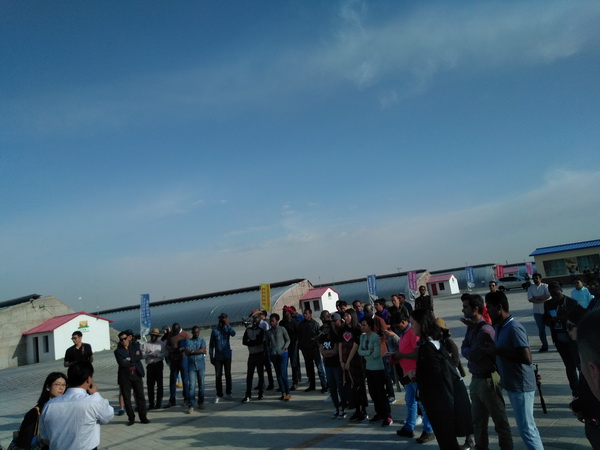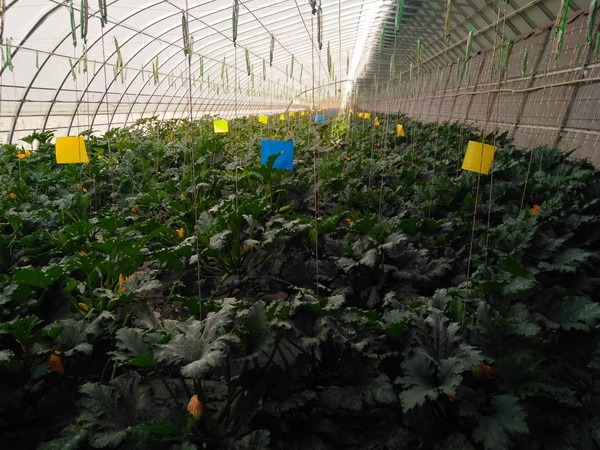


The fruits and vegetables grown in Zongzhai Gobi greenhouses are pollution-free. Photo: Kimeng Hilton
The Zongzhai Gobi desert agricultural industrial park in Suzhou District, Jiuquan City, China’s northwestern Gansu province is testimony to how much the people have overcome environmental and climatic challenges to turn their area into nationally-acknowledged breadbasket. Simply put, the demonstration centre is today an agricultural marvel, making use of soil-less and drip irrigation farming technologies to produce large quantities of 27 crop types a year.
It covers 3,500 Chinese Mu (233.3 hectares) consisting of 1,032 greenhouses. With annual crop yields of 100,000 kg for large greenhouses and revenue of 100,000 RMB a year for such areas of cultivation, the park is renowned today for its efficiency, high quality products and productivity.
Hostinging 42 African, South Asian and Southeast Asian journalists round the site on September 17, 2017, Li Chengping, the Communist Party of China Secretary for Zongzhai County, said the project was launched in 2009 at the cost of 2 million RMB. The excited, impressed and attentive journalists listened as Li explained how such a farming method had to be adopted in the stony Gobi desert that has almost the same ecology and climate like most of Gansu province.

Foreign journalists listen to explanations on work at Zongzhai Gobi desert greenhouses. Photo: Kimeng Hilton
Three main types of crops are cultivated in the Zongzhai Gobi desert agricultural industrial park - vegetables, fruits and fungus or mushrooms. The vegetables and fruits grown in the greenhouses include tomatoes, cucumber, peaches, grapes, small tomatoes, etc. The park is designed to cover 10,000 Chinese Mu (666.7 hectares) costing 102 million RMB, the local CPC official explained. Meanwhile, roads, power and water have been provided and 1,032 high-standard solar greenhouses constructed, offering a pollution-free vegetable production base of about 3,500 Chinese Mu (233.3 hectares).
Li recalled that the park was constructed using 17 advanced practical technologies. These include organic ecological soil-less cultivation, hole tray seedling matrix, drone pollination, fertigation, use of smart gathering vehicles and intelligent greenhouse control system.
The agricultural industrial park has a number of distinctive features. It makes full use of the idle Gobi desert and also helps in resolving the land dilemma between food and vegetable production. The use of water is largely economized with the application of micro-spraying drip irrigation technology, thereby reducing the water consumption of each greenhouse by 25 percent.

Journalists visit a cucumber greenhouse in Zongzhai Town, Gansu province on September 17. Photo: Kimeng Hilton
Crop rotation in the Gobi desert greenhouses is carried out scientifically, ensuring continual production all-year-round. As a result, the annual revenue for each greenhouse is at least 30,000 RMB, nearly 30 percent higher than average greenhouses elsewhere. Zongzhai Gobi desert agricultural industrial park vegetables pose no pollution risks to the environment as they are free from soil-borne diseases and are high quality and profitability.
The vegetables are sold online, making them available to a larger clientele. By employing advanced technology, agricultural engineers are able to achieve real-time monitoring of temperature, humidity and illumination in each greenhouse through automation of ventilation, shutter-rolling, watering and fertilizing.

Vegetables cultivation under drip irrigation conditions in Gobi desert. Photo: Kimeng Hilton
*Kimeng Hilton Ndukong, a contributor to People’s Daily Online, is Sub-Editor for World News with Cameroon Tribune bilingual daily newspaper in Cameroon. He is currently a 2017 China-Africa Press Centre, CAPC fellow.
 Fire brigade in Shanghai holds group wedding
Fire brigade in Shanghai holds group wedding Tourists enjoy ice sculptures in Datan Town, north China
Tourists enjoy ice sculptures in Datan Town, north China Sunset scenery of Dayan Pagoda in Xi'an
Sunset scenery of Dayan Pagoda in Xi'an Tourists have fun at scenic spot in Nanlong Town, NW China
Tourists have fun at scenic spot in Nanlong Town, NW China Harbin attracts tourists by making best use of ice in winter
Harbin attracts tourists by making best use of ice in winter In pics: FIS Alpine Ski Women's World Cup Slalom
In pics: FIS Alpine Ski Women's World Cup Slalom Black-necked cranes rest at reservoir in Lhunzhub County, Lhasa
Black-necked cranes rest at reservoir in Lhunzhub County, Lhasa China's FAST telescope will be available to foreign scientists in April
China's FAST telescope will be available to foreign scientists in April "She power" plays indispensable role in poverty alleviation
"She power" plays indispensable role in poverty alleviation Top 10 world news events of People's Daily in 2020
Top 10 world news events of People's Daily in 2020 Top 10 China news events of People's Daily in 2020
Top 10 China news events of People's Daily in 2020 Top 10 media buzzwords of 2020
Top 10 media buzzwords of 2020 Year-ender:10 major tourism stories of 2020
Year-ender:10 major tourism stories of 2020 No interference in Venezuelan issues
No interference in Venezuelan issues
 Biz prepares for trade spat
Biz prepares for trade spat
 Broadcasting Continent
Broadcasting Continent Australia wins Chinese CEOs as US loses
Australia wins Chinese CEOs as US loses